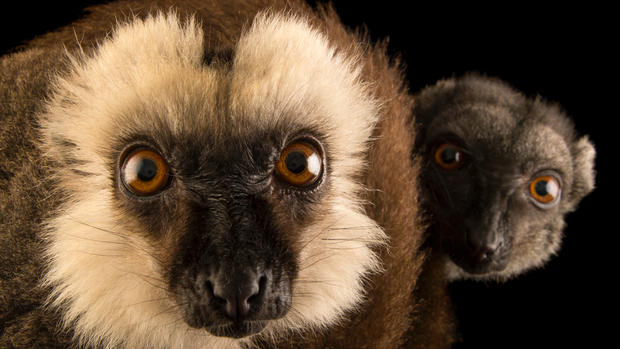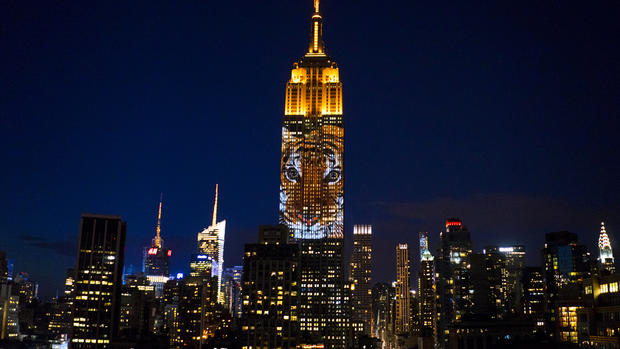The Photo Ark: Preserving species before they disappear
Many animal species are at risk of vanishing. It's a calamity photographer and "Sunday Morning" Contributor Joel Sartore is trying hard to prevent. Our Cover Story is reported now by Martha Teichner:
They haunt you, these eyes -- as intended.
Eye to eye, you're supposed to regard the greatest, the tiniest, and the lowliest equally.
"If we can get down and look these species in the eye, really get down low and really look 'em in the eye, and you see how lovely they are and how much intelligence there is there," said Joel Sartore, "they're telling us something. I mean, they're shouting it to me."
For ten years now, the National Geographic photographer has made it his life's mission to be their messenger and, he hopes, their protector -- their Noah building a photographic ark.
His "Photo Ark" currently houses images of more than 5,000 species, rolling past the viewer. "It would take two hours to see them all," he said. "It's supposed to just overwhelm people with what life looks like on Earth."
And what might soon be extinct.
He showed Teichner a photo of the Rabb's fringe-limbed treefrog, the very last of his kind. "His name's Toughie, because he's outlived the projection. He's like nine years old, at least, and so when he's gone, that's it. They will be extinct."
Sartore's Photo Ark will be at the National Geographic Society in Washington, D.C., until April.
Included is a northern white rhino that he photographed this summer at the Dvůr Králové Zoo in the Czech Republic. "There were five at the time. This is a very old female named Babire, and she died one week to the day after we photographed her.
"Now, there are four."
Also pictured is a Columbia Basin pygmy rabbit, which has gone extinct. "She was very near the end of her life," Sartore said. "It's intentional that you can see her from the other end of the exhibit. We wanted people to see her and have the experience of, well, this is what we're talking about. This is the consequence if we ignore the world around us. We lose thousands of species to extinction per day on this planet."
"Scientists, over the past half-billion years, have seen five mass extinctions -- think of things like volcanoes and asteroids hitting the Earth," said anthropologist Catherine Workman, Senior Director of National Geographic's Protecting Wildlife Initiative. "Scientists currently describe the loss of plants and animals now as the sixth mass extinction.
"We're losing animals at a rate 1000 times that of rates of extinction of the past, which is unparalleled. It's an extinction we haven't seen since the loss of the dinosaurs 65 million years ago. We have habitat loss, we have hunting, we have climate change, and the combination of all these threats on a planet that's shortly going to have 7.5 billion people is really hammering the planet's biodiversity."
Joel Sartore didn't set out to create a Photo Ark. It began as an act of desperation, when his wife, Kathy, was diagnosed with breast cancer, and he needed to stay home in Lincoln, Nebraska.
"I just thought, I need to shoot something. Kathy's gonna be sick for a long time, and on the days when she felt better through the chemo cycles, I just needed something to shoot."
So this world traveler, who's shot 35 stories for National Geographic (including six covers), drove to the Lincoln Children's Zoo, a mile from his house, and asked if he could photograph the animals.
"They let me take a naked mole rat and put it on a white background," Sartore said. "That's how we started it. And then I did a couple of blue and black poison dart frogs, I think. And that was 5,400 species ago."
Sartore is not quite half-way through photographing all 12,000 animal species in captivity, endangered or not. He figures it will take him the rest of his life to finish.
He's taken pictures at more than 200 zoos in the U.S. alone, including a porcupine at the St. Louis Zoo, and wrangled flamingos (not quite like getting your ducks in a row).
Success is not always guaranteed. And there can be hazards, as when these birds get angry. "This bird is the nastiest, most bad-ass bird I've ever had to do."
So why zoo animals?
"Zoos often have the only populations of these animals -- they're gone in the wild," said Sartore. "And if it weren't for zoos, a lot of these species I shoot would be extinct by now, hands down."
Sartore accepts that people fall in love with fuzzy, cute animals, like the Fennec fox. But he wants us to appreciate the importance of the un-cuddly ones, the ones we've never heard of.
His portraits' all-black or all-white backgrounds, he said, "bring them to life and give them a voice. And this is often the only voice they'll ever have before they go away. This is their only chance to sing, in a way."
His animals have been projected on the Empire State Building and at the U.N. Soon they'll be shown on the Vatican. Anywhere he can, as often as he can, Joel Sartore pleads for their lives.
This, he says, is the best time ever to be alive to save species.
He told an audience of students, "Did you know that you, young lady, have the power to change the world? You totally do! Any of you guys could. There are so many species that are on the ropes now, so many species in need of protection -- tiny species, large species -- that all of us have a great opportunity."
He hopes his photographs will get people to help -- and he likes to hook them young.
Sartore showed some students examples of animals in his exhibit that have been saved. "I do take comfort in the fact that all is not lost by any means. In this country whooping crane, black-footed ferret, California condor, Mexican gray wolf, all those animals got down to fewer than two dozen, and they're all stable now -- not in the best shape, but stable -- and that just speaks volumes to the fact that people do care.
"But we have to let them know these animals exist and that they 're in trouble and what the need is."
The Photo Ark is Joel Sartore's invitation to look them in the eye ... to look hard.
For more info:
- joelsartore.com | The Photo Ark project
- Photo Ark exhibit at the National Geographic Society, Washington, D.C. (through April 11, 2016)
- Follow @JoelSartore on Twitter and Facebook
- St. Louis Zoo
- Lincoln Children's Zoo
- Racing Extinction
- Gallery: A true urban jungle
- Gallery: Joel Sartore's migratory birds






